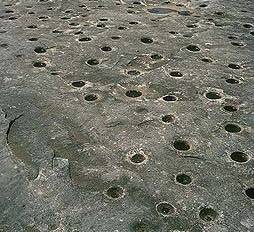Streams erode in three ways. In limestone and other soluble terranes,
they erode their channel by solution. The newly dissolved materials are
added to the ions derived from weathering. Streams also carry solid clasts.
As the various clasts,  especially
the larger ones, impact against the channel, they scour it by abrasion.
Even a few pebbles swirling over long periods of time cut pot holes
in the bottom of the river. In unconsolidated channels, sediments are picked
up by the hydraulic lifting action of turbulent flow.
especially
the larger ones, impact against the channel, they scour it by abrasion.
Even a few pebbles swirling over long periods of time cut pot holes
in the bottom of the river. In unconsolidated channels, sediments are picked
up by the hydraulic lifting action of turbulent flow.
Although it may be difficult to visualize the amount of sediments eroded and transported by streams, keep in mind that the continents lose their soils and regolith to streams at the rate of nearly three inches every 1000 years. The Mississipi river alone carries nearly a million tons of sediments to the Gulf of Mexico each day. If this rate of erosion were to continue unchanged, the Rockies would essentially be gone in 50 million years, or about 1% of the earth's history.
Transport and depositional processes
Over time, the finer sediments are carried off and the coarser particles lag behind, the particles become sorted by size. Because abrasion occurs between particles during the trip downstream, overall size and angularity decrease, roundness and sphericity increase and minerals continue to chemically weather. The extent to which sediments have been modified is called maturity.
Sediment transport is a function of energy. During episodes of higher energy, such as floods, capacity increases as do competency and cutting power (the amount of erosion). Pebbles which were part of the bed load, become part of the saltation load and sand becomes part of the flotation load. Conversely, as energy decreases, so do erosion, competency and capacity. The river begins to deposit and the largest particles are the first to settle out. Transport is really a steady state condition between erosion and deposition.
In the long run, a stream will also adjust itself to its water and sediment loads, and deposition at the mouth will equal erosion at the headwaters. Such a stream is considered to be in dynamic equilibrium, to be graded.